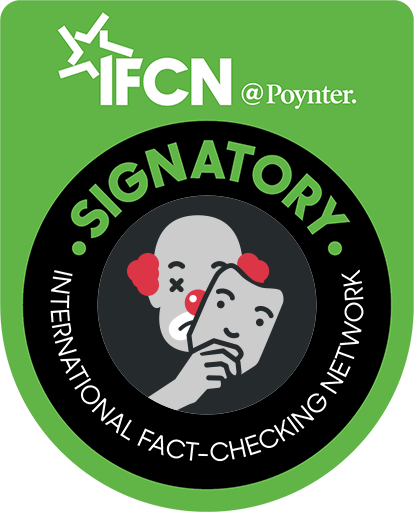In the following series on “website farms”, we bring you an overview of the first such network, which centers around a Facebook page, “Sarajevo grad” (“Sarajevo city”).
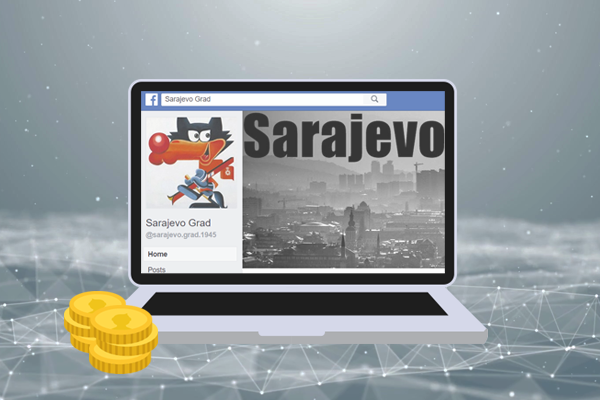
Website farms are networks of internet and Facebook pages that link to each other. As a rule, they contain pages that look like media, that is, information websites. Although articles that look like news can be found on such sites, there is no newsroom behind them or journalists who write for them.
The only purpose of their existence is to make money, and therefore they are full of advertisements. The content itself can be divided into two categories – texts, recordings and other content downloaded from the media or other similar websites; and fake news and misinformation fabricated to encourage visitors to click on the page. An introductory analysis of the series on “website farms”, to help you understand how they work and what is their purpose, can be found at the link “Website farms”: A business in which your time becomes someone else’s money.
The first example we identified is the “farm” that developed around the Facebook page “Sarajevo grad”, created in 2011. In this text, we will go through the chronology of the development of this farm, from the first page and the first website to the content that is shared today.
“SARAJEVO GRAD” (“SARAJEVO CITY”)
At the end of October 2011, the “Sarajevo Grad” page appeared on Facebook. On the same day, an album with over 100 photos of various sights and panoramic views of Sarajevo was uploaded to the site.
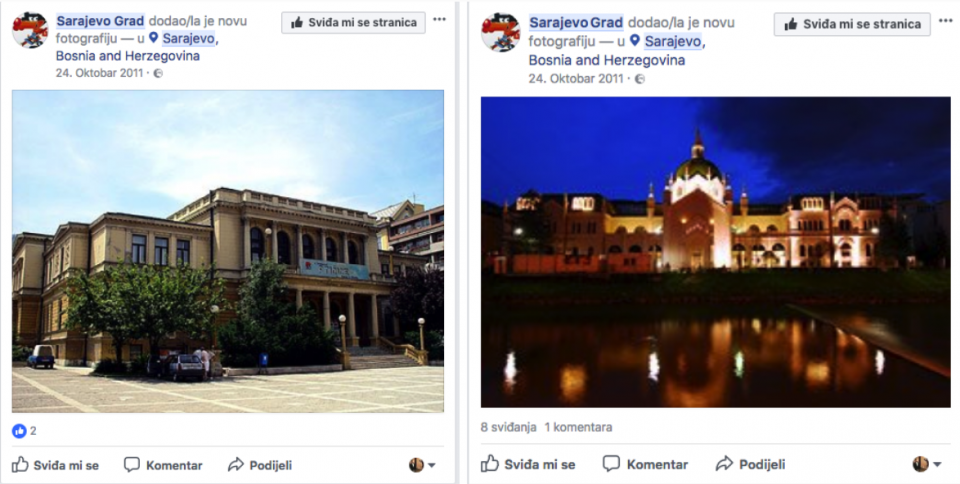
In the first years of its operation, this page was used to share news related to Sarajevo from various information websites. Also, photos of Sarajevo’s sights continued to be published regularly and various “viral” content such as “funny” photos.

This is how the Facebook page functioned and gathered followers until 2015. The first website whose contents began to be regularly shared on this page in 2015 (without being an already established and well-known medium) was “Vijestiizregije.com”. According to public data on domain ownership, it was leased by Nermin Dzumhur. The domain was in his possession until November 2017, when the website was shut down.
“Cicelicka.com” is the second website to appear on this Facebook page in the same year. The domain was leased in July 2015 in the name of Ajka Dzumhur. She owned the domain for almost three years. As of April 2018, the website no longer exists.
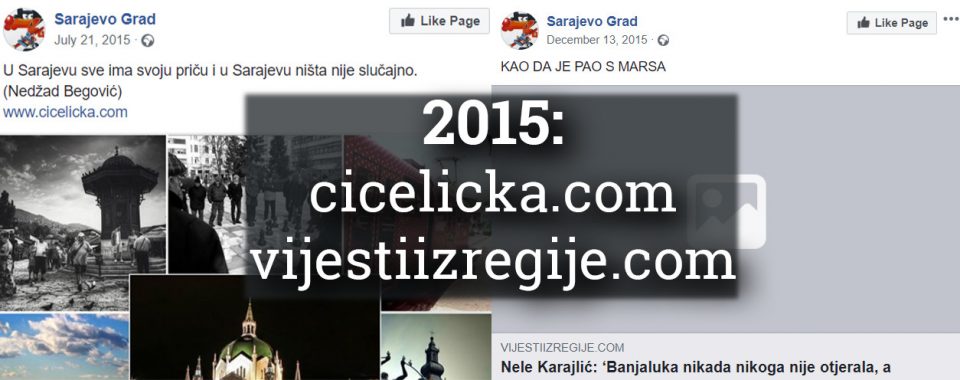
The Facebook page “Sarajevo grad” experienced expansion during 2016, when several new portals appeared on it. Nermin Dzumhur registered under his name the following domains: “Sarajevograd.info” (November 2015), “Sarajevograd.click” (June 2016) and “Thevijestiizregije.info”, which no longer exists. All other domains that appeared during 2016 were leased anonymously. In February, the websites “Cicelicka.info” and “Vijestiizregije.info” were created, the website “Cicelicka.xyz” originated in June, and in August, they were joined by “Vijestiizregije.xyz”, which also no longer exists.
Raskrinkavanje had tried to contact the owner of these websites twice, specifically those who had prominent email addresses when they were active. Until the publication of this text, we have not received any answer to our inquiries. We have not been able to determine the actual ownership of these and other “linked” registered websites while hiding information about the domain owner.
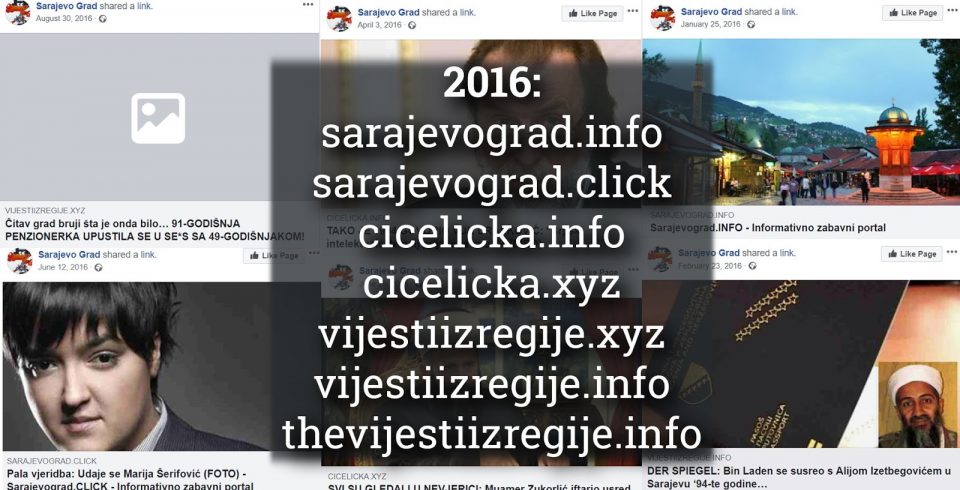
The new website that appeared in 2017 was “Vijestiizregije.space”, followed by “Thevijestiizregije.space”, “Sarajevograd.org”, “Sarajevograd.me”, “Sarajevograd.space” and “Thesarajevograd.info”. Three websites that differ in their name from the others also appeared in 2017, and these are “Bosanskihumor.com”, “Bosanskihumor.space” and “Bosnaihercegovina.org”.
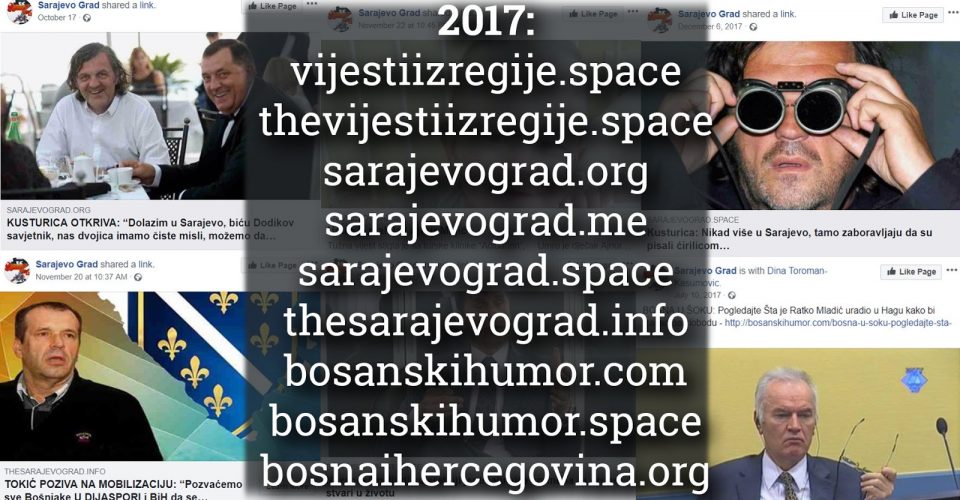
The new website “wave” took place in October 2018, when “Thesarajevograd.club”, “Mysarajevograd.com” and “Sarajevograd.club” were created.

In addition to using several variations of the same name (“Vijesti iz regije”, “Sarajevo grad” and “Cicelicka”), all these websites have an identical appearance. Apart from the extensions of the domains/links themselves, the only difference is the logo located in the upper left corner of the website and which changes in each new version, although there are repetitions of “themes” – such as using the logo of the 1984 Sarajevo Olympics.
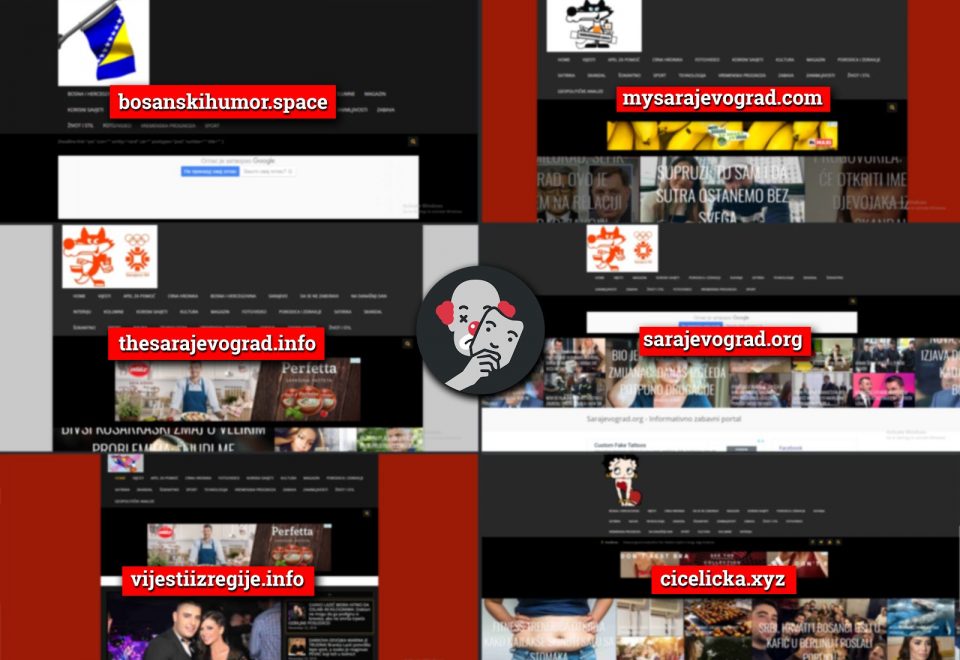
None of these websites features an impressum, “about us” section, or any proprietary, editorial or contact information.
The frequent removal of existing and the creation of new websites is mainly the result of such sites regularly violating the rules of Google AdSense to “artificially” increase the earnings from advertisements placed through this service. The moment Google “realizes” that the page does not follow the rules and withdraws its ads from it, its existence loses its meaning, and the owner then creates a new page whose content he distributes through the same developed Facebook “network”.
Other Facebook pages
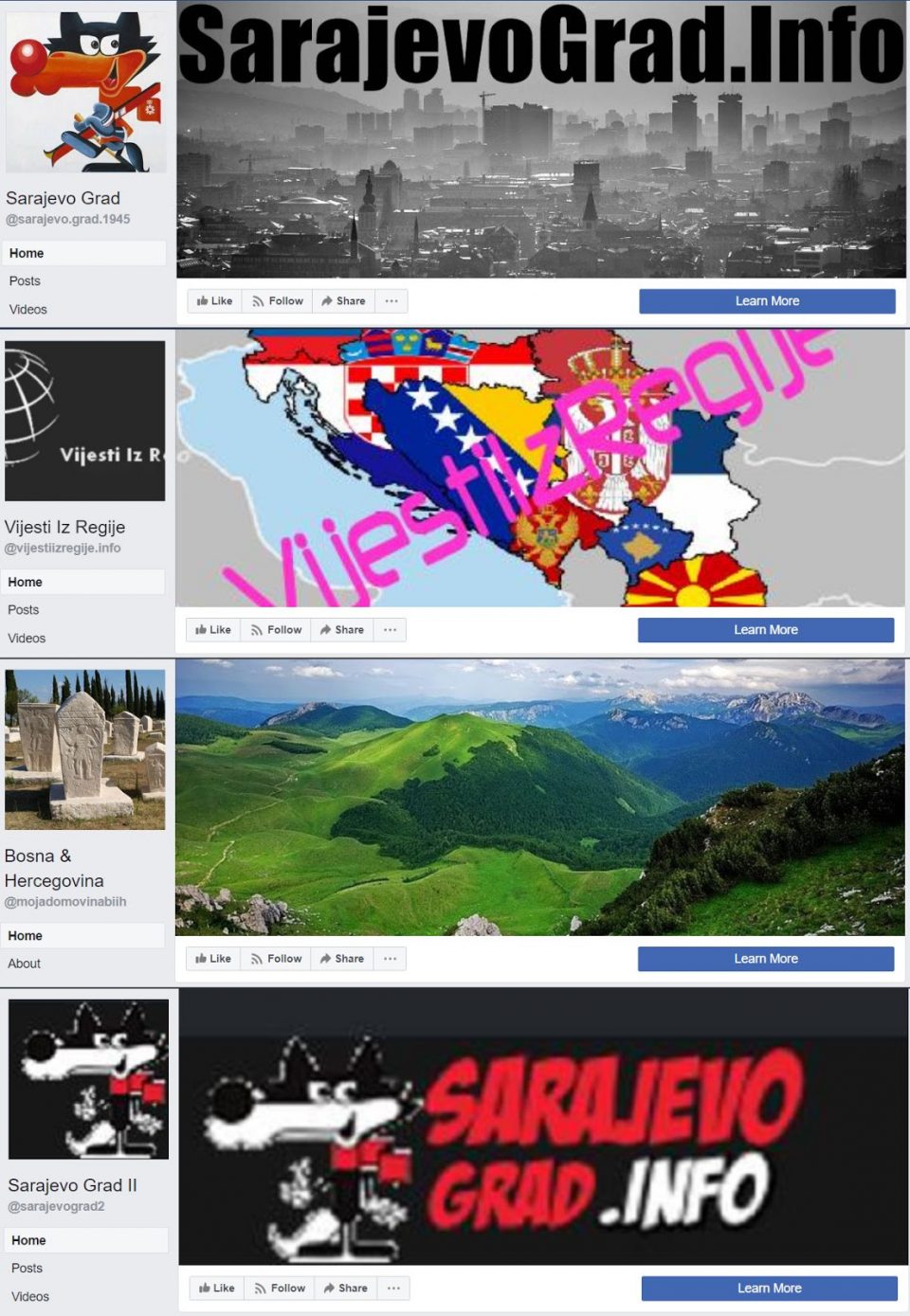
In addition to the main Facebook page, “Sarajevo Grad” which has 267,000 likes, there are several other pages where the content of all these websites is shared.
In October 2012, the page “Vjesti iz regije” was created, which currently has 54,000 likes.
In the same month, but two years later, the list was joined by “Bosna i Hercegovina”, which currently has 69,000 likes.
“Sarajevo Grad II” was created in November 2014 and currently has 76,000 likes.
All listed Facebook pages share links to each of these active websites at a given time. All sites also practice the same way of increasing interaction and likes, usually by posting different photos downloaded from the internet, often with a question in the description, which encourages commenting and sharing posts. Greater visibility of shared posts, and an increase in the number of likes/followers of the page, ultimately means more visits to websites linked to these pages – that is, more clicks that generate revenue from Google’s AdSense ads.
These four Facebook pages together have almost 500,000 “likes”. The informative value of the content that reaches half a million people every day via Facebook is zero. They consist of news taken from other media, misinformation, clickbait headlines and fake news. These are, for example, the titles and ratings of some of the articles from the listed websites that we already analyzed:
- Everyone is on their feet: Migrants have caused chaos in Sarajevo, tram traffic has been suspended! (fake news)
- YOU WILL BE SHOCKED – VEGETA IS POISON: Here’s what you’re killing your family with! (fake news)
- If you see this on the door of your car, call the police immediately, or it will be stolen (fake news)
- RUSSIANS ADMITTED: We are preparing for a devastating world war – DO NOT HOPE FOR ANY GOOD! (disinformation)
- IZETBEGOVIC SOLD THE STATE: The solution for BiH is three entities and two districts – We must be divided! (fake news)
- IF YOU REMOVE THE HAIR FROM YOUR NOSE, YOU WILL DIE! (disinformation)
- SHOCKING: Six-year-old from RS illustrated happiness with a drawing with the Serbian flag next to Srebrenica coffins (fake news)
- SHOCKING DISCOVERY: Fahrudin Radoncic’s ancestors killed Sarajevo’s creator, vakif and a highly religious person – Gazi Husrev-bey (PHOTO) (fake news)
- SCANDALOUS DECISION OF SARAJEVO: They are digging up 13,000 Serbian graves because they disturb the cemetery’s appearance! (fake news)
- CRIMINAL RECEIVES HIS PUNISHMENT: War criminal Ratko Mladic brutally raped in prison … (fake news)
All analyzes of articles published on the websites from the mentioned “farm” can be found at THIS LINK.
Therefore, websites like these make money by misinforming their readers and/or stealing other people’s content. They harm the people who read them and the media who really produced the news and invested time and money in it – sending journalists to the scene, interviewing interlocutors, paying for photos and recordings they publish, etc. Their work, which requires financial and human resources, is then taken over by such anonymous websites, which without any investment benefit from the earnings they make through advertising.
Additionally, when the owners of such websites download other people’s content, they often modify them to make it more attractive because this is news that has already been published somewhere. This is why other people’s articles are often “repackaged” by fabricating or exaggerating information, especially in the title, so that their articles are readable. That is why the “clickbait” rating often appears with their articles.
The content of such “media” is useless because they represent sensational recycling of news that has already been published on the pages of real media. In addition to the time lost reading “bad” or false news, they can also be very harmful because the audience that is “bombarded” with misinformation gets a distorted picture of actual events and phenomena. Based on such content, people can make wrong decisions on important issues, ranging from personal (such as the health and well-being of themselves and their families) to political ones (for whom they will vote in elections). There is probably no need to talk about the spread of fear, hatred and mistrust that usually accompany the operation of such websites.
(Author: Emir Zulejhić, Raskrinkavanje.ba)
